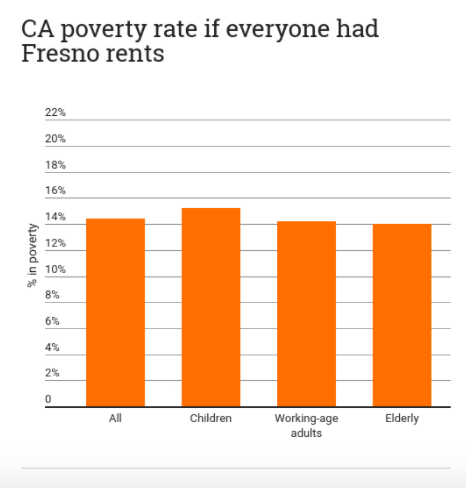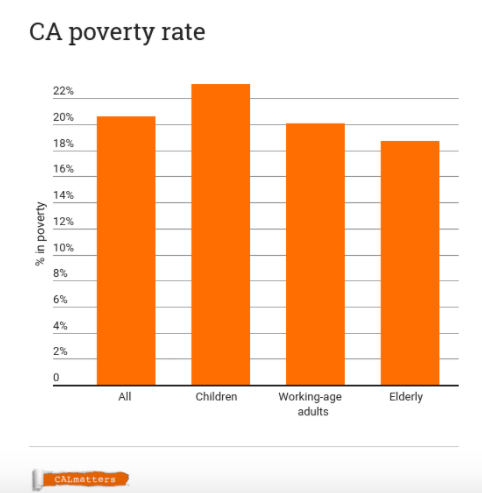How Sky-High Housing Costs Make California the Poorest State

Malibu, California Shutterstock
The Golden State has been the poorest state in the nation under the vastly more sophisticated “supplemental” poverty measure since the alternative statistic was created.
This article was originally published by CALmatters, a nonpartisan, nonprofit journalism venture dedicated to explaining California policies and politics. Learn more about CALmatters here.
California leads the nation once again in a statistic no state wants to boast about.
When the cost of living is factored in, the Golden State has the highest poverty rate in the country. More than 20 percent of its residents struggle to make ends meet, according to recently released Census figures. That’s nearly 8 million people.
Unfortunately for Californians, this year’s poverty numbers are not an aberration. The Census began releasing state-by-state results for its “supplemental poverty measure” in 2011, in an attempt to improve upon the outdated and heavily criticized official poverty statistics.
In the less sophisticated “official” measure, a family of four in San Francisco or Los Angeles or San Diego faces exactly the same poverty threshold—$24,339 annually—as a family in rural Mississippi. That’s despite the fact that you can rent a three-bedroom, two-bathroom 1,200-square-foot house in Horn Lake, Mississippi, for the same price ($850 a month) as half a living room in the Bay Area.
California has been the poorest state in the nation under the vastly more sophisticated “supplemental” poverty measure since the alternative statistic was created (Mississippi is poorest under the old measure). It’s not even really that close: Florida has the second highest rate, at 18.7 percent.
Part of the reason California tops the list year after year is a byproduct of how the supplemental poverty measure is calculated. It’s a three-year moving average, so year-over-year changes can’t swing a state’s poverty rate one way or another all that much.
The Census uses data dating to 2011 to calculate the cost of living, so even the improved poverty rate could be underestimating how big a drain housing has been on California’s poor. The biggest jumps in housing costs—like those we’ve seen in Sacramento and other mid-size California cities in recent years—typically apply to a relatively small percentage of renters finding new apartments. But ask any California renter whether they’d rather be paying 2011 rents or 2017 rents, and they’ll ask you for the keys to the DeLorean as soon as possible.
What exactly is the role of housing in California’s poverty problem? There are a couple ways to answer that question, none perfectly satisfactory.
One method: What would poverty look like if everyone in California had cheaper rents?
Researchers at the the Public Policy Institute of California, which has developed its own California-specific alternative poverty measure, tried to simulate an answer to that question. Researchers there ran a model of the state’s poverty rate with every Californian bearing a cost of living similar to that in Fresno County, where a family of four making about $25,000 would not be considered poor.
The result?


The overall poverty rate drops dramatically (from about 21 percent to 14 percent), with nearly 2.4 million Californians lifted above the poverty line. The effect is most pronounced among children, who are disproportionately likely to live in higher-cost regions of the state. The child poverty rate drops nearly 8 percentage points—about 717,000 kids—once the cost of living is lowered.
Relocating every poor family in the state to Fresno is, well, not a practical policy consideration. And housing subsidies for low-income families currently make only a small dent in the poverty rate, at least compared to some other safety-net programs.
(Advocates for the poor argue that’s a great reason to dramatically expanding housing subsidies).
A group of researchers at Columbia University re-created the Census supplemental poverty measure for all states with data stretching back to the late 1960s. Under this measure, California started looking considerably different from the rest of the United States in the early 1980s.
But notably, while California’s supplemental poverty rate has remained significantly above the national average in recent years primarily because of housing costs, in absolute terms the state is actually in better shape than it was in the early 1990s, when more than one in four Californians lived below the poverty line. And the recession of the early 1990s paled in comparison to the Great Recession of the late 2000s.
That’s partly because of the significant expansion of federal and state poverty programs to California families in the past three decades. In 1991, researchers estimate, such programs reduced California poverty by about four percentage points. In 2014, those same programs (and new ones) cut hardship by more than twice as much.
Matt Levin is a data reporter for CALmatters, where this article was originally published.
NEXT STORY: For Some Black Immigrants, Life in Limbo





